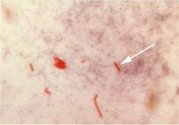PURPOSE: Tuberculosis is one of the leading infectious diseases in adults, causing around 3 million deaths annually. Research on understanding the host defense and immunopathogenesis of tuberculosis is necessary because there is an urgent need for a new vaccine and adjunctive immunotherapy, particularly in patients with drug resistant Mycobacterium tuberculosis infection. Recently, many aspects of cytokine dynamics in patients with active pulmonary tuberculosis have been investigated through ex-vivo studies with specific or crude mycobacterial antigens, or M. tuberculosis.
METHODS: We used whole blood culture method in order to evaluate IL-12 and TNF-alpha productions in active TB patients, tuberculin skin test positive and negative healthy controls. We investigated the productions of IL-12, TNF-alpha in response to nonspecific mitogens and M. tuberculosis specific antigens. We used many tuberculous antigens for stimulation. The tuberculous antigens are culture filtrate proteins (CFP), purified protein derivatives (PPD), antigen 85A M. tuberculosis proteins (Ag85A), early secretory antigen target-6 (ESAT-6), 38k Dalton antigen (38kDa), RNA polymerase [beta] subunit B1 (rpoB1), RNA polymerase [beta] subunits B2 (rpoB1), arabinofuranasyl lipoarabinomannan(araLAM), manosyl-capped lipoarabinomannan(manLAM), and non-specific mitogens are concanavalinA(ConA), lipopolysaccaride(LPS), phytohaemagglutinin(PHA). In addition, we monitored the changes of each cytokine production in TB patients during the course of therapeutic treatment.
RESULTS: In our study, production of IL-12, TNF-alpha to nonmannose-capped lipoarabinomannan(araLAM) increased significantly in active tuberculosis patients compared to healthy controls, After 2 month, production of IL-12, TNF-alpha to araLAM decreased significantly throughout the therapeutic periods.
CONCLUSION: Our study suggest that productions of IL-12, TNF-alpha plays a important role in the pathogenesis and treatment of tuberculosis.
CLINICAL IMPLICATIONS: Whole blood culture method to IL-12, TNF-alpha may be used in the diagnosis of active pulmonary tuberculosis.
DISCLOSURE: Young Kim, None.
Young S. Kim MD * Jin W. Moon MD Chang H. Han MD Shin M. Kang MD Moo S. Park MD Se K. Kim MD Joon Chang MD Sung K. Kim MD Yonsei Univ College of Medicine, Seoul, South Korea
COPYRIGHT 2005 American College of Chest Physicians
COPYRIGHT 2005 Gale Group



